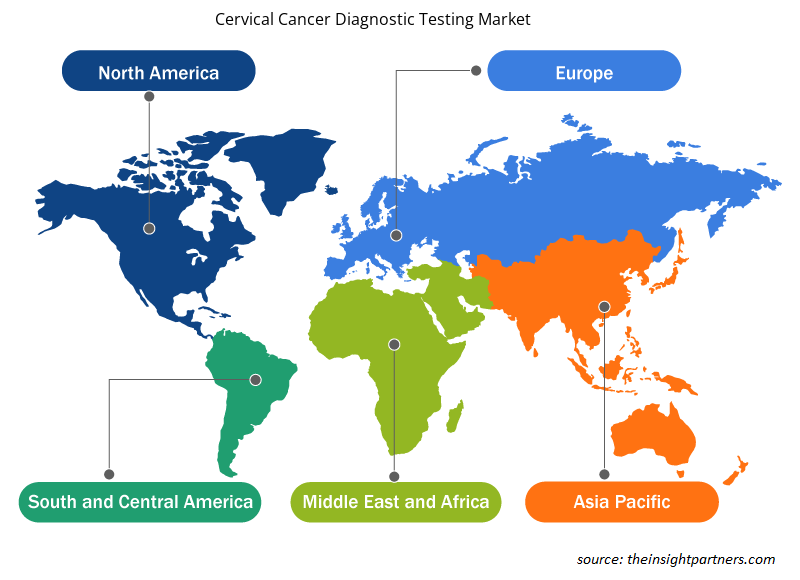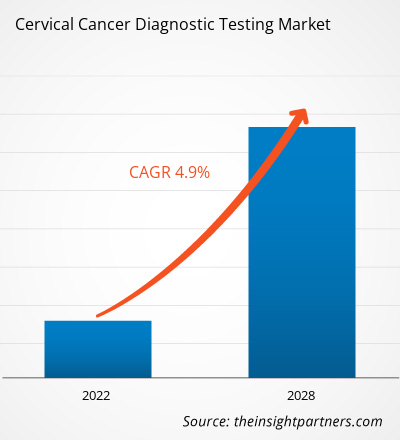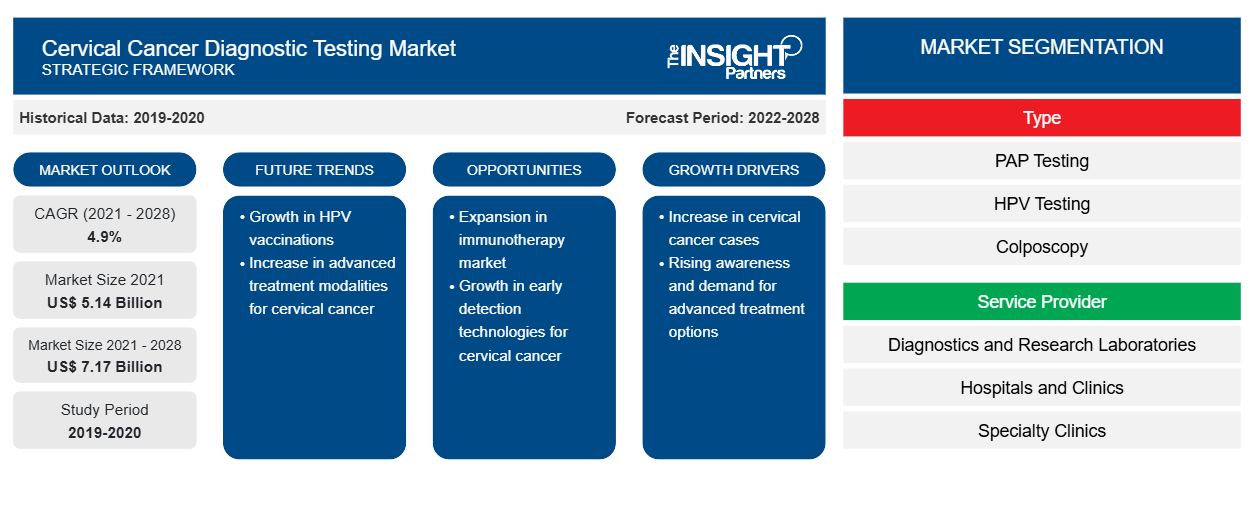宫颈癌诊断检测市场规模预计将从 2021 年的 51.4125 亿美元增至 2028 年的 71.6592 亿美元;预计 2021 年至 2028 年的复合年增长率为 4.9%。
宫颈癌死亡率很高(几乎 50%),但通过早期发现和预防可以降低死亡率。癌前病变为预防和治疗提供了机会,因为疾病进展通常会延迟。然而,由于缺乏认识或无法获得诊断服务,许多病例是在疾病进展的后期才被发现的。人乳头瘤病毒 (HPV) 是宫颈癌的主要原因,通常通过性接触传播。HPV 菌株有 100 多种,其中 13 种是高风险或致癌的。活性基因 - E6 或 E7 - 决定了 HPV 菌株是高风险还是低风险。E6 与 p53 结合,导致蛋白水解破坏。另一方面,E7 与视网膜母细胞瘤结合;这种结合取代了先前附着的转录因子,导致细胞周期停止,细胞凋亡调节受到抑制。HPV 测试可检测宫颈细胞中的人乳头瘤病毒。发展中国家资源匮乏地区采用的其他筛查方法是 HPV DNA 检测和目视检查。定期进行宫颈筛查有助于早期发现宫颈癌,从而降低该疾病的死亡率。每三年,建议所有 21 至 65 岁的女性进行一次巴氏涂片检查,建议 30 至 65 岁的女性同时进行巴氏涂片和 HPV 检测。就收入而言,这种类型在 2021 年占据了宫颈癌筛查市场的主导地位,预计在预测期内将继续占据主导地位。
定制此报告以满足您的需求
您可以免费定制任何报告,包括本报告的部分内容、国家级分析、Excel 数据包,以及为初创企业和大学提供优惠和折扣
-
获取此报告的关键市场趋势。这个免费样品将包括数据分析,从市场趋势到估计和预测。
市场洞察
预测期内癌症患病率上升推动宫颈癌诊断检测市场增长
癌症已成为全球死亡的主要原因。根据世界卫生组织 (WHO) 的数据,2019 年,癌症是 183 个国家 70 岁以下人群的第一大死亡原因,也是 123 个国家的第四大死亡原因。此外,根据世卫组织 2021 年 3 月发布的数据,2020 年因不同类型癌症死亡的人数约为 1000 万人。全球女性宫颈癌发病率的上升推动了宫颈癌诊断检测市场的增长。据世卫组织统计,每年有超过 270,000 名女性死于宫颈癌。由于疾病诊断较晚,低收入国家的宫颈癌死亡率更高。由于越来越多的人接受宫颈癌诊断测试来早期发现疾病,预计未来几年市场将增长。
癌症患病率的上升给全世界的医疗保健系统带来了负担。根据国际癌症研究机构 (IARC) 的数据,到 2040 年,全球新发癌症病例预计将达到约 2750 万,到 2040 年,癌症可能导致约 1.63 亿人死亡。生活方式的改变、吸烟、体力活动减少以及不确定的健康和气候条件等因素将在未来几年导致世界癌症负担进一步加重。
基于类型的洞察
根据类型,宫颈癌诊断检测市场细分为 PAP 检测、HPV 检测、阴道镜检查、宫颈活检、膀胱镜检查等。2021 年,PAP 检测占据了最大的市场份额,预计在 2021-2028 年期间将实现最高的复合年增长率。
基于服务提供商的见解
根据服务提供商,市场细分为研究、诊断和研究实验室、医院和诊所、专科诊所和家庭护理服务。2021 年,诊断和研究实验室部门占据了最大的市场份额,预计在 2021-2028 年期间将实现最高的复合年增长率。
在宫颈癌诊断检测市场运营的公司正在采用各种策略,例如产品创新,以满足全球不断变化的客户需求并在全球市场上保持其品牌名称。
宫颈癌诊断检测市场——细分
宫颈癌诊断检测市场根据类型和服务提供商进行细分。根据类型,市场细分为 PAP 检测、HPV 检测、阴道镜检查、宫颈活检、膀胱镜检查等。根据服务提供商,市场进一步细分为诊断和研究实验室、医院和诊所、专科诊所和家庭护理服务。在地理
方面,宫颈癌诊断检测市场细分为北美(美国、加拿大和墨西哥)、欧洲(法国、德国、意大利、英国、西班牙和欧洲其他地区)、亚太地区(澳大利亚、中国、印度、日本、韩国和亚太地区其他地区)、中东和非洲(沙特阿拉伯、南非、阿联酋和 MEA 其他地区)以及南美洲和中美洲(巴西、阿根廷和 SCAM 其他地区)。
宫颈癌诊断检测市场区域洞察
Insight Partners 的分析师已详细解释了预测期内影响宫颈癌诊断检测市场的区域趋势和因素。本节还讨论了北美、欧洲、亚太地区、中东和非洲以及南美和中美洲的宫颈癌诊断检测市场细分和地理位置。

- 获取宫颈癌诊断检测市场的区域特定数据
宫颈癌诊断检测市场报告范围
| 报告属性 | 细节 |
|---|---|
| 2021 年市场规模 | 51.4 亿美元 |
| 2028 年市场规模 | 71.7亿美元 |
| 全球复合年增长率(2021 - 2028) | 4.9% |
| 史料 | 2019-2020 |
| 预测期 | 2022-2028 |
| 涵盖的领域 |
按类型
|
| 覆盖地区和国家 |
北美
|
| 市场领导者和主要公司简介 |
|
宫颈癌诊断检测市场参与者密度:了解其对业务动态的影响
宫颈癌诊断检测市场正在快速增长,这得益于终端用户需求的不断增长,而这些需求又源于消费者偏好的不断变化、技术进步以及对产品优势的认识不断提高等因素。随着需求的增加,企业正在扩大其产品范围,进行创新以满足消费者的需求,并利用新兴趋势,从而进一步推动市场增长。
市场参与者密度是指在特定市场或行业内运营的企业或公司的分布情况。它表明在给定市场空间中,相对于其规模或总市场价值,有多少竞争对手(市场参与者)存在。
在宫颈癌诊断检测市场运营的主要公司有:
- F.霍夫曼-拉罗氏有限公司
- 雅培
- Quest Diagnostics 公司
- 凯杰公司
- Hologic 公司
免责声明:上面列出的公司没有按照任何特定顺序排列。

- 了解宫颈癌诊断检测市场的主要参与者概况
公司简介
- F.霍夫曼-罗氏有限公司
- 雅培
- Quest Diagnostics 公司
- 凯杰公司
- Hologic 公司
- DYSIS 医疗公司
- Femasys 公司
- Guided Therapeutics, Inc.
- 库珀集团
- 屋宇署
- 历史分析(2 年)、基准年、预测(7 年)及复合年增长率
- PEST和SWOT分析
- 市场规模、价值/数量 - 全球、区域、国家
- 行业和竞争格局
- Excel 数据集
近期报告
相关报告
客户评价
购买理由
- 明智的决策
- 了解市场动态
- 竞争分析
- 客户洞察
- 市场预测
- 风险规避
- 战略规划
- 投资论证
- 识别新兴市场
- 优化营销策略
- 提升运营效率
- 顺应监管趋势























 获取免费样品 - 宫颈癌诊断检测市场
获取免费样品 - 宫颈癌诊断检测市场